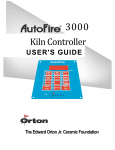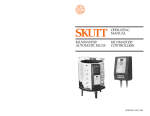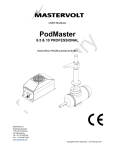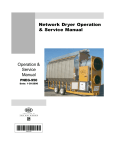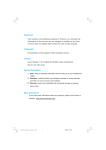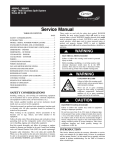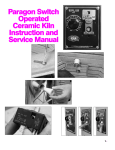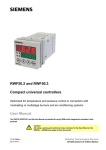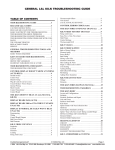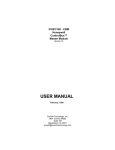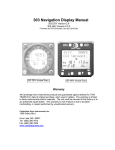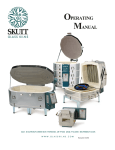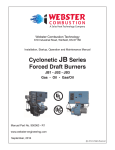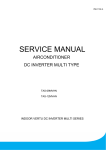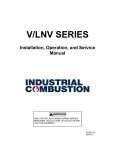Download AutofirePlusUnitemp manual - Edward Orton Ceramic Foundation
Transcript
AutoFire® Kiln Controller User’s Guide AutoFire Plus AutoFire Pro AutoFire UniTemp™ AutoFire UniTemp™ - Solid State Relay Option Orton Ceramic Foundation Electronic Control & Monitoring Products Orton Ceramic Foundation 6991 Old 3C Highway Westerville, Ohio 43082-9026 Telephone: (614) 895-2663 Fax: (614) 895-5610 Revision 5.0 – September 1999 Table of Contents Introduction 1 AutoFire Kiln Controller Models 2 Features and Benefits 3 Firing Your Kiln 4 Test Firing 5 Quick Reference Section Cone Fire Program Cone Fire Example User Program Using A User Program Display Reference Alarm Reference 6 7 8 9 10 11 12 Options Available Level 1 Level 2 13 13 17 Alarm Descriptions 20 PLOG (Diagnostic) Error Codes 22 Power Recovery 23 Preset Cone Fire Programs 25 Preset Cone Firing Schedules 27 Remote Monitoring 29 Technical Specifications 30 Warranty 31 Appendices A – Reproducible User Program Sheets B – Pyrometric Cones C – Temperature Equivalents D – Vent Fan Options Available E – Connecting Thermocouples F – Typical Wiring Diagrams G – Program Lock Instructions 32 33 34 35 37 38 41 AutoFire® Kiln Controller User’s Guide INTRODUCTION Congratulations on purchasing Orton's AutoFire® controller. You now have the finest controller available for use in firing glass and ceramics. It will provide more precise control and many valuable features not available with other controllers. It can even be programmed and the firing monitored from a personal computer, using software available from Orton. Contact your kiln manufacturer or Orton for more information on this feature. This User’s Guide will explain the features, benefits, options and operation of your new Orton AutoFire® Kiln Controller. Use the “Quick start reference card” for normal operation of the controller and this Guide for more detailed descriptions of controller features. Before making your first firing, take the time to become familiar with the features of this product. With proper use and installation, you will be assured many years of superior performance and service. If you have any comments or questions, feel free to contact the Orton Ceramic Foundation or your Orton Distributor or Reseller. We would enjoy hearing from you. Again, thanks for choosing an Orton product. For simplicity, AutoFire® has only 8 keys. The main keys allow firing programs to be selected and the delay start feature to be used with a limited number of keystrokes. The OPTIONS key provides you with access to many other features. Take the time to learn the features you want to regularly use. All models of the AutoFire® controller use the same basic programming, but not all features are available on every model. AutoFire® controllers use proprietary PID Plus control software that eliminates the excessive cycling associated with control schemes found with most other controllers. Cycling occurs when the controller turns the kiln on or off and the temperature does not closely follow the program selected. PID Plus minimizes the effect of cycling by anticipating how the kiln temperature will respond when power is turned on and off. AutoFire® controllers store programs and calibration data in memory even when powered off. If during a firing, the power goes out, it remembers how far the firing has progressed to determine whether it can be successfully resumed when power is reapplied (see page 23). Thermocouples All controllers depend on thermocouples placed in the kiln to measure temperature. With time, the output of most thermocouples will change, this is called drift. When drift occurs, the thermocouple no longer measures the same temperature as it did when it was new. Typically, drift causes the kiln temperature to be higher than the temperature displayed by the controller. Type K thermocouples drift more than Type S and these need to be replaced after 50-100 firings, or when damaged. Orton recommends that Type K thermocouples normally not be used at higher temperatures (above 2100°F, unless they are made of 8 gage wire or enclosed in a protective sheath. Smaller diameter (14 gage) wire are not advisable for repeat firings above 2100°F. Type S can be used when firings regularly exceed 2100°F. Pyrometric Cones Orton recommends using witness cones in each firing to help determine if the kiln and controller are firing properly. These also give a permanent record of your firing. Orton cones bend when a specific amount of heatwork has been received. Bending temperatures will be different when the heating rate is changed. During the last 60 to 90 minutes, the AutoFire® controller always heats the kiln at 108°F/hr (60°C/hr), during a selected Conefire firing. If the kiln cannot maintain this heating rate, then a lower shut-off temperature is calculated to minimize overheating of the ware. The overall firing time of the program will be longer. This occurs when the final firing temperature at the time of completion is lower then the anticipated temperature. 1 AutoFire® Kiln Controller User’s Guide Pyrometric cones and their use is explained fully in Appendix B, while a Temperature Equivalent chart is included in Appendix C. AutoFire KILN CONTROLLER MODELS The Orton AutoFire® family of kiln controllers includes four models to meet most users’ needs. The features unique to each model is given below: AutoFire® Plus Control With a Single Type K, N, or S Thermocouple Power Output to Mechanical Relay(s) for Heating Element Control Power Output to a Mechanical Relay for Vent Fan Control (option) AutoFire® Pro Control With a Single Type K, N, or S Thermocouple Power Output to Solid State Relay for Heating Element Control Power Output to a Mechanical Relay for Safety Shut-off Power Output to a Mechanical Relay for Vent Fan Control (option) AutoFire® UniTemp™ Proprietary Algorithm Minimizes Temperature Gradients Control With 2 Type K, N, or S Thermocouples Power Output to Mechanical Relays for Heating Elements Control of Up to 3 Independent Heating Zones Power Output to a Mechanical Relay for Vent Fan Control (option) AutoFire® UniTemp™ - Solid State Relay Option Proprietary Algorithm Minimizes Temperature Gradients Control With 2 Type K, N, or S Thermocouples Power Output to Solid State Relays for Heating Elements Control of Up to 3 Independent Heating Zones Power Output to a Mechanical Relay for Safety Shut Off The AutoFire® Plus/Pro models referred to in this User’s Guide are those listed above. References to AutoFire® UniTemp™ refer to both the AutoFire® UniTemp™ and the AutoFire® UniTemp™ Solid State Relay Option models listed above. Using AutoFire® with a Kiln-Sitter If you have a Kiln-Sitter on the kiln, you may use a Cone 10 bar or cone under the sensing rod to shut off power if the kiln reaches high temperatures. This bar will last many firings. You can also remove the cone or bar and prop up the sensing rod with a piece of refractory material. Set the Kiln-Sitter timer for two hours longer than the firing. 2 AutoFire® Kiln Controller User’s Guide FEATURES AND BENEFITS Your new Orton AutoFire® Kiln Controller has an extensive list of standard features, a user-friendly operator interface, and a robust temperature control algorithm. These combine to provide what we believe to be the best temperature controller for electric kilns and furnaces on the market today. The following is a list of the features we believe you will find most useful as you begin using your new AutoFire® Kiln Controller: Thermocouple Type Choose from Type K, N, or S Thermocouples (We recommend the use of Type K up to 2100°F, Type S above 2100°F) Cone Firings Easy firing to Cone Numbers 022 - 12, with hold time (additional 5 to 30 minutes of hold can be added) Proper Heat Work Orton’s patented method of adjusting firing to ensure proper heat work Cone Table Reference temperatures for each cone number (60°C/hr or 108°F/hr heating rates) User Programs 10 “to 20” Ramp/Hold Segments for each program, retained even when power is turned off Accurate Control Proprietary PID Plus temperature control algorithm assures more accurate firings. This also includes Soft Start and Overshoot Control Delay Start Automatically starts kiln at a later time (up to 9999 minutes later) Set-Point Control Setting hold time at 9999 minutes keeps kiln at set point temperature indefinitely Firing Speed Control Speed up or slow down your firing (from -40% to +40%) to better match the loading of your kiln Program Review Review your firing program even while the kiln is being fired Skip Step If you want to skip to the next ramp in a User Program. Calibrate to a Cone Use Cone Offset to adjust the kiln to fire to a cone to adjust the firing temperature from -38 °F to +20 °F Temperature Alarm Kiln Temperature Threshold Alarm can be set to audibly notify you when a temperature is reached Power Interruption Recovery from a power interruption occurs when proper to do so Temperature Units Select either Fahrenheit (°F) or Centigrade (°C) Units Diagnostics Audible Alarms and error codes indicate when the controller or the kiln is not firing correctly Computer Interface Program and monitor up to 16 kilns from a Personal Computer 3 AutoFire® Kiln Controller User’s Guide Firing Your Kiln The purpose of firing your ware is to develop long lasting, durable, valuable, and useful products. When fired properly, good-looking results are obtained. If improperly fired, the value of the ware is greatly reduced, disappointment occurs, and in some cases, the object is discarded. When this happens, your effort and anticipation leading up to the firing is wasted. Understanding and controlling what occurs during firing will minimize problems and increase your ability to get consistently good results. The firing, after all, is usually the final process in creating your “masterpiece.” The AutoFire® Kiln Controller contains 3 preset programs – Lo Fire, Mid Fire, and Hi Fire. These programs were designed for the firing of normal loads of hobby ceramics. As a rule, the firing in the kiln needs to be slowed down in certain temperature ranges to allow for carbon burnout and to improve temperature uniformity. The preset programs are designed with this in mind; however, when a kiln is more heavily loaded or thrown ware with thicker walls are used, additional care is needed during the firing because the ramps for the preset programs may be too fast. Experiment to determine the best firing conditions. It is also important that the kiln be vented properly - Orton recommends the use of a downdraft venting system, such as an Orton KilnVent®. When firing to a cone number, the AutoFire® kiln controller constantly monitors the actual heating rate of the kiln. If the kiln does not fire as rapidly as programmed, the controller firmware recalculates and adjusts the top firing temperature to compensate for the slower firing rate. This process more accurately fires to the cone number selected. At slower heating rates, cones deform at slightly lower temperatures. At faster heating rates, cones deform at slightly higher temperatures. This ability to recalculate and compensate to fire to a cone value is a unique, patented feature of all Orton Electronic Kiln Control Products. The AutoFire® Kiln Controller provides three preprogrammed firing cycle programs for preset cone firing. These preprogrammed firing cycle programs and the corresponding preset cone fire programs follow: Program Purpose Lo Fire Decal, Luster, and China Firings Mid Fire Glaze Firings Bisque and Earthenware Firings Hi Fire Stoneware and Porcelain Firings Typical Cone Value Cone 019 Cone 06 Cone 04 Cone 6 Cone Range 022 - 011 010 - 01 010 - 01 1 - 12 4 AutoFire® Kiln Controller User’s Guide The Test Firing Completing a test firing with your new AutoFire® Kiln Controller will help you become familiar with the operation and features of the controller, as well as determine that the controller is performing as expected. Follow your kiln manufacturer's Instruction Manual for setting up your kiln and firing to properly break-in the kiln’s heating elements. For an AutoFire® Plus or Pro model, place a set of Orton Self-Supporting Cones on the middle shelf in your kiln so that they can be seen through the kiln peephole. If you have the AutoFire® UniTemp™ model controller, also place cones on the top and bottom shelves of kiln to examine temperature uniformity within your kiln. Use a series of cones close to the temperature that you plan to fire to during an actual firing. A three cone firing setup is recommended, a Guide Cone, Firing Cone, and a Guard Cone. For example, if you were firing to a 1945°F (Cone 04), you would use a Cone 03, Cone 04, and a Cone 05, to do the test firings. To evaluate heat distribution, place a set of witness cones on each shelf during the test firing. Most kilns fire more uniformly at Cone 6 than they do below Cone 06. With the UniTemp™, cones should bend similarly, no matter what the firing temperature. Provide ventilation for the kiln in accordance with your kiln manual or Orton KilnVent® instruction manual. If your kiln has limit switches, turn all switches to the “On” or “highest” position. Begin the firing, refer to page 7 of this manual for using preset cone programs. After the firing, before opening the kiln to remove your cones, make sure the kiln has cooled sufficiently. Examine the fired cones. Some variation in the bending of the cones may occur, depending on how the kiln was loaded. This includes the size of the load, its distribution on the shelves and the location of the cones. It is a good practice to use a witness cone in every firing. This provides a permanent record of the firing conditions in the kiln and can help you identify changes in the way your kiln is firing. Test fire approximately every 25 firings. Test conditions should be consistent from firing to firing. Save the sets of witness cones as records of the firings. Review them periodically to note variations or drift in successive firings. If thermocouple drift starts to occur, recheck the heat distribution. If one area of the kiln is much hotter or cooler than another, it may indicate that one or more heating elements need replaced. If there is a major change in the amount of bending of the firing cone, the most likely cause is thermocouple damage or deterioration. Replace the thermocouple and retest. If replacing the thermocouple does not restore the performance to previous levels, the controller or kiln may require additional service. The Cone Offset feature (see page 15) can be used to adjust the temperature of a cone firing to more closely match the bending of a cone. 5 AutoFire® Kiln Controller User’s Guide QUICK REFERENCE SECTION This Quick Reference Section is to help familiarize you with the most often used features of your AutoFire® Kiln Controller. Guides to Cone Firing, User Programs, Display References, and Alarm References are included. We recommend you read the entire User’s Guide to become familiar with all the exciting benefits and features of your AutoFire®. The Keypad • • • • Ergonomically designed 8-button Keypad High brightness 4-digit, 7-segment LED display Audible feedback Washable high-tech graphic panel The eight buttons on the AutoFire® keypad provide the following functions: ENTER - load whatever is displayed into memory, and to acknowledge deviation and PLOG alarms, if they occur. START/STOP - begin or end a firing, to store a user’s program, and to acknowledge ‘CPLt’ or ‘Abort’ shown in the display CONE FIRE - select a cone number from preset programs (Page 3) USER PROGRAM - input your own program (Page 5) DELAY START - input a time delay in minutes OPTIONS - access other features (Page 7&8) ARROWS - change the display, and scroll through options The AutoFire® may be ordered without Cone Fire programs, thus on some models, the keypad may not show the Cone Fire button. Those working in glass do not need Cone Fire programs, but will still benefit by the advanced features of the AutoFire®. 6 AutoFire® Kiln Controller User’s Guide Cone Fire - using your controller for preset cone programs. • • The Up Arrow increments the value 0 – 9, or scrolls through selections one at a time. The Right Arrow shifts editing digit to the right, or scrolls through selections one at a time. The AutoFire® family of kiln controllers feature easy firing to any cone number. Just follow these simple steps: (Controller temperature is displayed in °F) Step Press Description Display 1 CONE FIRE Enters the Cone Fire mode. The "06" is the cone program name and the "1828" is the corresponding cone deformation temperature at a 108°F/hr ramp. 06, 1828 2 UP ARROW/ RIGHT ARROW Scroll to the desired cone number. The desired preset cone program name and the corresponding cone deformation temperature at the 108°F/hr ramp will be alternatively displayed. 022, 1086 to 12, 2382 3 ENTER Selects the desired cone number currently displayed. Hd, . 0 Then advances to Hold Time (Hd). Use arrows to select up to 30 minutes of hold time at the end of Cone Fire program. If no hold time is desired then simply press [ENTER]. The controller returns to Idle mode. 4 UP ARROW/ RIGHT ARROW Scroll to the desired hold time. The default is 0 hold. (Hold times are in 5 minute increments) 0, 5, 10, 15, 20, 25, 30 5 ENTER Selects the displayed hold time. IdLE (At this point additional options can be selected, such as delay start, firing speed, or cone offset) 6 STOP/START Starts the selected cone firing. The current kiln temperature is displayed during an active firing cycle. XXXX, where XXXX is current temperature 7 - When the active firing cycle is completed. The final temperature reached by the kiln will be alternately shown as CPLt in the display. CPLt, Final Temperature 8 STOP/START Acknowledges completion of the firing cycle and returns to IdLE mode. Also functions as Abort (Abrt) during a firing process. IdLE Abrt For more information on additional features and options, refer to the appropriate sections in this User’s Guide. 7 AutoFire® Kiln Controller User’s Guide Cone Fire Example Fire to Cone 6, increase firing speed 20%, and add a 15-minute hold. (controller temperature is displayed in °F) Just follow these simple steps: Press Description Display 1 CONE FIRE Enters the Cone Fire mode. 06, 1828 2 UP ARROW (Press UP ARROW 11 times) Scrolls to display of 6 (Cone Number). 6, 2231 Hd, . 0 Step 3 ENTER Selects cone number 6. 4 UP ARROW (Press UP ARROW 3 times) Scroll to display of 15 (Hold Time). Hd, . 15 5 ENTER Selects the displayed hold time. IdLE 6 OPTIONS Selects options menu. SPd 7 ENTER Selects SPd (speed) option (default is standard) Std 8 RIGHT ARROW ( Press RIGHT ARROW 2 times) Scroll to display of F 20 (Speed) F 20 SPd 9 ENTER Selects 20% firing speed increase 10 UP ARROW Scroll to display of rEtn (or wait 20 seconds) 11 ENTER Returns to IdLE mode IdLE 12 STOP/ START Starts the selected cone firing. 0074, (current kiln temperature) Note! rEtn The actual kiln temperature is displayed during an active firing cycle. 13 - When the active firing cycle is completed. The final temperature reached by the kiln will be alternately displayed with the CPLt display. CPLt, Final Temperature 14 STOP/START Acknowledges completion of the completed firing cycle and returns to IdLE mode. Also functions as the Abort (Abrt) during a firing process. IdLE Abrt 8 AutoFire® Kiln Controller User’s Guide USER Program - using your controller for custom firing programs. • The Up Arrow increments the value 0 – 9, or scrolls through selections one at a time. • The Right Arrow shifts editing digit to the right, or scrolls through selections one at a time. The AutoFire® family of kiln controllers feature 10 segment user programs for custom firing profiles. Just follow these simple steps: (controller temperature is displayed in °F) Step Press Description Display 1 USER PROGRAM Enters the User Program mode. Allows the entering of a 'New ' program, or editing of an existing one. Usr # (where # is a value of 1, 2, 3, or 4) 2 UP/RIGHT ARROWS Scroll to the desired User Program. USr1, 2, 3, or 4 3 ENTER Selects the desired User Program. Displays the first program segment name, Ramp 1 rA 1, xxxx - where xxxx is the ramp rate 4 RIGHT ARROW Selects the digit to be modified. The selected digit will flash. xxxx 5 UP ARROW Scroll the selected digit to the desired value. 0xxx 6 - Repeat steps 4 & 5 till desired value is displayed 0360- ramp of 360°/hr 7 ENTER Stores the new value and displays the next program segment name, Dwell Temperature (°F 1 or °C 1) °F 1 , xxxx - where xxxx is dwell Temp. 8 RIGHT ARROW Selects the digit to be modified. The selected digit flashes xxxx 9 UP ARROW Scroll the selected digit to the desired value. 1xxx 10 - Repeat steps 8 & 9 till desired value is displayed 1032 - dwell temp. of 1032°F 11 ENTER Stores the new value and displays the third program segment name, Dwell Time 1 (Hd 1). Hd 1, 0.000 12 RIGHT ARROW Selects the digit to be modified. The selected digit will flash. 0.000 13 UP ARROW Scroll the selected digit to the desired value. 0.120 (2 hour hold) 14 - Repeat steps 11 & 12 till desired value is displayed 15 ENTER Stores new value and displays the next program ramp segment. Skip to Step #17 if no more ramps are desired. rA 2, 0000 Repeat Steps 4-14 for each ramp, dwell temperature, and dwell time desired. 16 17 STOP/START Acknowledges completion of the completed program and stores the current program into memory. IdLE 18 STOP/START Starts the current user program just entered xxxx – (current kiln temperature) 19 STOP/START Aborts firing cycle, if necessary during firing Abrt 9 AutoFire® Kiln Controller User’s Guide Or acknowledges completion of the firing cycle and returns to the main display. IdLE Using a Pre-Programmed USER Program: After you have stored a custom user program, the controller retains the program in memory for easy recall later. You may select and run any of the pre-programmed user programs in 4 easy steps. While the controller is in IdLE mode: 1. 2. 3. 4. Press USER PROGRAM Use the RIGHT ARROW to scroll through the four user programs Press USER PROGRAM again to select the desired user program Press STOP/START to start the program immediately or DELAY START to start later. The DELAY START allows user to specify in minutes a time to delay before starting the firing. When selecting this feature, simply press DELAY START and enter into the display the number of minutes of delay time (i.e. 0120 = 2 hours) then press ENTER to store the value. To then start the delay sequence, press STOP/START. The controller will then display ‘d.ELA’ and the delay time remaining before controller will automatically start. To review a program without the worry of erasing or deleting any program steps, use the Program Review Mode. The Program Review Mode under Level One options (refer to page 14) allows for reviewing your user program without affecting the program entries. Editing a Pre-Programmed User Program: Once a user program is stored, it is easy to make a change to the program. Refer to page 9 of this manual (User Program - using your controller for custom firing programs) for details on how to enter a program. NOTE! You will need to go through the complete program before pressing STOP/START to re-save the program, or you will delete part of your program. In each program segment that does not need changed, you simply press ENTER to advance to the next segment. When you get to a segment that needs modified, use the arrow keys to edit the value and then ENTER to select it and advance to the next program segment. If you previously had a 4-ramp program, be sure that you step through all 4 ramps again until you get to a new ramp segment (rA 5 for this example) before exiting by pressing STOP/START. It is this easy to make a change to an existing program. During an active firing you can also edit the user program. Use the steps explained in the previous paragraph except for pressing STOP/START for finalizing and saving the user program. Instead, once you have made the changes in the program, continue to press the ENTER through the remaining steps of the program. The controller will save the changes and return to the active firing at the point in the program prior to entering edit mode. During the time the controller is in edit mode, the relays will not cycle, therefore do not take more time then needed to make your changes. Included in this manual, Appendix A, is a reproducible User Program chart used to help record custom firing programs. This chart can be used prior to entering a program into the controller to provide a visual copy of each program sequence. 10 AutoFire® Kiln Controller User’s Guide Display Reference The following is a reference guide to the various messages that may be displayed while using your AutoFire® Kiln Controller: Display 0--1 Abrt AInG ALAr bAdP CHGCPLt CtbL d.ELA °F # °C # dIFF ELEC Fail ‘Fn #’ Hd # HI F Id IdLE Lo Lo F LoUn ≡IdF ≡odl nnnn oFSt P1 P2 P3 ProG rA # rHEo rEL Ser SoFt Spd SStP tCo tC1 tEdE rEtn tC tCnt Un Usr# Meaning Display Temperatures of both thermocouples (UniTemp™ Models Only) Active Firing Cycle Aborted Factory Use Only Kiln Temperature Threshold Alarm (user adjustable) Invalid step in User Program Change Temperature Units, °F or °C Firing Cycle Complete (final temperature reached will alternately be displayed) Cone Table - list of Cone Numbers and their bending temperatures (see Appendix B) Delay mode (will alternately display the remaining minutes before start of firing) Dwell Temperature °F (#: 1-10) - set temperature for controller to ramp to Dwell Temperature °C (#: 1-10) - set temperature for controller to ramp to Temperature Difference between two thermocouples (UniTemp™ Models Only) Display Electronics Temperature Thermocouple failure Vent Fan mode of operation Soak Time in minutes (#: 1-10) – set time for controller to hold temperature Hi Fire (display used when reviewing program during a cone firing) Specify RS-485 Controller Identification Node (number) Controller in Idle mode (ready to program or to start a firing) Program Lock 'On' (Cone Fire and User Program cannot be modified) Lo Fire (display used when reviewing program during a cone firing) Program Lock Mode (use to secure program settings from being changed) Mid Fire (display used when reviewing program during a cone firing ) Display Model Number (i.e. 0000 = Plus, 0003 = UniTemp™) Factory Use Only Cone Offset, allows for adjusting display temperature to match witness cones Bad Firing, thermocouple opened just prior to loosing power Temperature Invalid Prior To Power Loss (greater then 255°) Power Loss Too Long (greater then 60 minutes) Program Review (use to review active firing program Cone fire or User Program) Ramp (#: 1-10) (rate per hour of temperature increase/decrease) Middle Zone Rheostat adjustment (UniTemp™ Models Only) Relays 1,2, or 3 (UniTemp™ Models Only) Display Serial Number Display Software Version Firing Speed (Std or ± 40%) Skip Step (used to advance to next ramp) Top thermocouple failure (Unitemp) Bottom termocouple failure (Unitemp) Temperature Deviation (default 100° corresponding alarm is FtH, FtC, HtdE, LtdE) Return Select Thermocouple Type K, N, or S Factory Use Only Program Lock 'Off', all programs and parameters can be modified User Program (#: 1-4) 11 AutoFire® Kiln Controller User’s Guide See next page for alarm messages and rest of manual for explanation. 12 AutoFire® Kiln Controller User’s Guide Alarm Reference The following is a reference guide to the alarm conditions that may be encountered while using your AutoFire® Kiln Controller (refer to page 20). [Audible Alarm Only] Display Meaning ALAr FtH Kiln Threshold Temperature reached threshold temperature alarm set by user Fail to Heat - kiln unable to heat at program ramp - temperature is below set-point by deviation amount* Fail to Cool - kiln unable to cool at program ramp - temperature is above set-point by deviation amount* High Temperature Deviation - kiln above set-point by deviation amount* Low Temperature Deviation - kiln below set-point by deviation amount* Low Battery Top Thermocouple has failed during firing (UniTemp™ Models Only) Bottom Thermocouple has failed during firing (UniTemp™ Models Only) Thermocouple Deviation Alarm - Factory Set for > 60°C (UniTemp™ Models Only) FtC HtdE LtdE LBAt tC 0 tC 1 tCdE *temperature deviation alarms occur when the kiln temperature differs from the set-point temperature by the alarm value. Typically, this is factory set at 100°F (56°C). It is changed through Options (see page 17&18) [Terminating Alarms] Display FtL EtH FAIL tC01 PLOG Meaning Firing Too Long - kiln not increasing in temperature. Temperature increasing at less than 15 O C/hr AND the firing time is 4 hours longer than the program segment Electronics Too Hot – electronics temperature exceeds 85 OC Open Thermocouple – thermocouple(s) has failed (opened) Both Thermocouples are 'open' in IdLE mode (UniTemp™ Models Only) Diagnostic tests to determine if controller operating properly ‘To reset PLOG error, press ‘ENTER’, refer to page 22 for additional details. 13 AutoFire® Kiln Controller User’s Guide OPTIONS AVAILABLE There are two levels of options available through the OPTIONS key. These enable the user to access additional firing features. Level 1 contains more frequently used options. These can be entered during either the idle mode (indicated by display flashing ldLE) or during an active firing cycle. Level 2 options are not used as often (these are described beginning on page 17). Not all options are available during a firing. Level 1 Options Display Spd ProG oFSt CtbL ALAr Option [Speed] [Program Review] [Cone Offset] [Cone Table] [Kiln Threshold Temperature] FAn* dIFF [Vent Fan] [Temperature Difference] rEtn [Return] SStP [Skip Step] Meaning Slows down or speeds up firing for cone programs Review selected program before or during a firing Adjusts firing temperature to match witness cones List of cone bending temperatures used in CONE FIRE Sets an alarm to sound when controller reaches the set point temperature and displays AlAr Sets the Vent Fan to on or off Displays the temperature difference between top and bottom thermocouples (UniTemp™ only) Returns to idle or run mode Allows adjustment to next program ramp * if enabled on controller and kiln wired for vent fan control To enter the Level 1 Options follow these steps: Step Press Description Display 1 OPTIONS SPd 2 UP ARROW/ RIGHT ARROW ENTER UP ARROW/ RIGHT ARROW ENTER Enters the Level 1 Options mode. The first option is displayed. Scroll through available Level 1 options Enables editing of currently displayed option View parameter(s) for selected option xxxx xxxx To exit viewing/editing of current parameters xxxx 3 4 5 xxxx Repeat steps 2 – 5 to continue viewing/editing options Where xxxx, is one of the level 1 options available, or the associated parameters. Controller will automatically return to IdLE or run mode after 20 seconds of inactivity IdLE 14 AutoFire® Kiln Controller SPd - Firing Speed User’s Guide Default Setting: Std The SPd feature adjusts how fast the kiln fires to compensate for the load in the kiln. Adjustments are made to the normal firing programs (refer to pg. 25 - Preset Cone Firing Programs). Slow settings can be used for heavy loads and the fast settings for light loads. Speed is applied only to increasing ramps and not to dwells (soaks). Speed does not apply to the last ramp of a cone firing. Firing Speed can only be modified during program setup, not during an active firing cycle. The Firing Speed choices are given below: Display Description Std S 10 S 20 S 30 S 40 F 10 F 20 F 30 F 40 Standard cone firing program Slow; increase firing time by 10%; decrease firing rate by 10% Slow; increase firing time by 20%; decrease firing rate by 20% Slow; increase firing time by 30%; decrease firing rate by 30% Slow; increase firing time by 40%; decrease firing rate by 40% Fast; decrease firing time by 10%; increase firing rate by 10% Fast; decrease firing time by 20%; increase firing rate by 20% Fast; decrease firing time by 30%; increase firing rate by 30% Fast; decrease firing time by 40%; increase firing rate by 40% NOTE: The Firing Speed adjustment is a permanent change to be applied to all future firings unless reset by user. This setting does not automatically reset itself. This feature is different from the earlier versions (prior to 0030), where Firing Speed Adjustments were reset to Standard after each firing. ProG - Program Review The ProG feature enables the user to review the current firing cycle of a preset cone program or a user program. The user cannot change the program while in this option. When selected, the option defaults to the current program segment. For preset cone programs, Program Review alternately displays the preset cone number and the corresponding cone deformation temperature at the 108°F/hr rate (60°C/hr). SStP - Skip Step The SStP feature allows the user to end a hold or a ramp during an active firing cycle and skip to the next program ramp. This is useful if a user wants to watch the firing to visually decide when to make a change, such as when glass is slumped. The Skip Step applies to User programs only and not to the preset cone fire programs. If the current step is a ramp then it will skip to the next ramp step and continue to ramp at the new rate. If the current step is a dwell then it will skip to the next ramp step and continue to ramp to the next temperature. If the current step is a ramp recovery step (after power loss, recovering to the prior dwell temperature), then it will skip to the next dwell step and dwell at the current temperature for the remainder of the unfinished dwell time. 15 AutoFire® Kiln Controller User’s Guide Default Setting: 0°°C, 0°°F oFSt - Cone Offset The oFSt feature enables the user to adjust or calibrate the preset cone programs, without changing to a different cone number. This is useful when the kiln does not properly bend the desired witness cone. This is common when using Type K thermocouples that drift with repeated firings. It is common for the kiln to be hotter than shown on the display. This feature may also be useful to compensate for the location and condition of the thermocouple. The Cone Offset or calibration feature allows the operator to specify a different temperature offset for each the three preset cone programs. This may be necessary since the same offset needed for a low temperature firing may not work for a higher temperature firing. The offset is applied to the appropriate preset cone programs, not to user programs. The user must first select the preset cone program (Lo Fire, Mid Fire, or Hi Fire) by selecting a Cone Number before assigning a Cone Offset. Cone Offset is then selected from the following list: Setting (°°F) Setting (°°C) Description 0F 5F 10 F 15 F 20 F -6 F -13 F -26 F -38 F 0C 3C 6C 8C 11 C -3 C -7 C -14 C -21 C No adjustment in heatwork Increases heatwork Increases heatwork Increases heatwork Increases heatwork Decreases heatwork Decreases heatwork Decreases heatwork Decreases heatwork The Cone Offset adjustment is a permanent change to be applied to all future firings when the preset cone program (Lo Fire, Mid Fire, or Hi Fire) is selected. The value is saved in memory. Each preset cone program can have its own unique Cone Offset. CtbL - Cone Table Default Setting: 06 The CtbL (Cone Table) feature allows the user to determine the deformation temperature corresponding to a selected cone number. Deformation temperatures are for a 60°C/hour (108°F/hour) rate. The default is cone 06. It is changed using the arrow keys. ALAr - Kiln Temperature Threshold Alarm (disabled) Default Setting: 32°°F or 0°°C The ALAr feature enables the user to specify a kiln temperature at which an alarm will be sounded and displayed. The alarm occurs when the kiln temperature is equal to or greater than the programmed kiln threshold temperature. It remains active until the user acknowledges the alarm by pressing the ENTER key. The alarm is disabled when 0000 is set in the display. 16 AutoFire® Kiln Controller User’s Guide FAn - Vent Fan Operation The FAn feature is enabled by the factory, and is only available when the controller has been pre-wired to permit a kiln vent to be turned on or off as part of the firing cycle. There are five modes of operation: Off – fan is always off during firing On – fan is always on during the firing OptA – fan is on at 100 OF and off at 1450 OF during heating fan on at 1000 OF and off at 300 OF during cooling OptB – fan on when 100 OF reached during heating and off when 300 OF reached during cooling Fn # – 4th segment of a USER program where vent fan is set for on or off For more information on how to program and use the vent fan feature, see Appendix D dIFF - Temperature Differential (UniTemp™ Model Only) The dIFF feature enables the user to display the temperature difference between the top thermocouple and the bottom thermocouple used with AutoFire® UniTemp™ Models. This feature is useful in determining temperature uniformity within a kiln during a firing. rEtn - Return The rEtn (Return) feature is used to exit the options mode and return to the IdLE or run display. 17 AutoFire® Kiln Controller User’s Guide Level 2 Options Level 2 Options provide the user with access to many additional and useful features of the controller. Most users will not use these options very often, if ever. Level 2 Options are accessed through the OPTIONS key, either when the controller is in Idle mode, or during an active firing cycle. UniTemp™ options are only available for their respective models and will not be displayed on a Plus or Pro model. Level 2 Options include the following: Meaning Display Option CHGtC Id tEdE Change temperature units from °F or °C Select a different thermocouple type (Type K, N, S) Assign an number from 0 to 15 to the controller Select temperature deviation for FtH, FtC, LtdE and HtdE alarms [Specify Number of Relays] Input the number of relays for UniTemp™ controller [Specify Middle Rheostat] Adjust power to middle zone of UniTemp™ controller [Thermocouple Temperatures] Displays top and bottom thermocouple temperatures with a UniTemp™ controller [Diagnostic Tool] Factory Use only [Diagnostic Tool] Factory Use only [Diagnostic Tool] Factory Use Only [Electronics Temperature] Displays temperature of the electronics [Program Lock] Lock or Unlock the current program. [Display Model Number] Displays the controller model number [Display Software Version] Displays the version of the control software [Display Serial Number] Displays the serial number of the controller [Return] Return to idle or run mode [Change Temperature Units] [Select Thermocouple Type] [Specify RS-485 Node ID] [Specify Alarm Value] rEL rHEo 0--1 AInG tCnt nnnn ELEC LoUn =odl SoFt Ser rEtn To enter the Level 2 Options mode follow these steps: Press Description Display 1 2 3 OPTIONS UP ARROW OPTIONS SPd rEtn CHG- 4 Enters the Basic Options mode. Scroll to the Return (rEtn) Option. Enters the Level Two Options mode. The first option is displayed. Scroll through available Level Two options UP ARROW/ RIGHT ARROW ENTER Enables editing of currently displayed option UP ARROW/ View parameter(s) for selected option RIGHT ARROW ENTER To exit viewing/editing of current parameters Repeat steps 4 – 7 to continue viewing/editing options Step 5 6 7 Where xxxx, is one of the level 1 options available, or the associated parameters. Controller automatically returns to IdLE or run mode after 20 seconds of inactivity CHG- - Change Temperature Units xxxx xxxx xxxx xxxx IdLE Default Setting: ° F The CHG- feature enables the user to change the temperature units between degrees Fahrenheit (°F) and degrees Centigrade (°C). The selected setting is saved in memory. When °C is selected, the right-most decimal point on the display is lit. 18 AutoFire® Kiln Controller tC - Select Thermocouple Type User’s Guide Default Setting: Type “S” The tC feature enables the user to select from type “K”, “N”, or “S” thermocouples. The controller uses this information to apply the correct thermocouple calibration information to the millivolt signal received from the thermocouple. The factory default thermocouple type is type “S” in order to keep kiln from overheating if electronics are reset to factory default settings. The selected type is saved in memory. ld - Specify RS-485 Node Identification Default Setting: 0 The Id feature is used to specify the kiln controller node for recognition by the computer. This is an identification number from 0 to 15, when the controller is one of up to 16 controllers in a network connected to a personal computer using Orton’s ControlMaster software product. For more information about ControlMaster, refer to page 29 on Remote Control and Monitoring. The factory default RS-485 node identification is 0. The selected setting is saved in memory. If multiple kilns are used in a system, the last controller in the network needs jumper JPR1 installed (page 40), all other controllers should have it removed. tEdE - Specify Alarm Value Default Setting: 100°°F (56°°C) The tEdE feature enables the user to select a temperature deviation value at which an audible and visual alarm will occur. The temperature deviation applies to the following alarms - FtH, FtC, LtdE and HtdE. When active, the alarm displays the type of deviation and sounds the buzzer once every 10 seconds. The display alternates with the actual kiln temperature. This alarm can be turned off by placing all zeros in display. rEL - Specify Number of Relays Default Setting: 3 (UniTemp™ Model Only) The rEL feature allows the user to specify the number of relays that will be used with AutoFire® UniTemp™ Models. The controller uses this information to control up to 3 independent heating zones. The specified value is saved in memory. Uniformity control is disabled when only 1 relay is selected. rHEo A Unitemp controller provides the capability to adjust the cycling of the middle heating elements. This option can be useful if the middle portion of the kiln runs slightly hotter than the top or bottom . A number from 0 to 200% , in increments of 5, can be selected. The default value for rHEo is 100. Values less than 100 will reduce the power to the middle heating elements, while values higher than 100 will increase the power. 0--1 - Display Temperature of Both Thermocouples (UniTemp™ Model Only) The 0--1 feature is used to display the temperature of the top thermocouple (tC 0) and the bottom thermocouple (tC 1) when two thermocouples are used with UniTemp™ Models. This feature allows temperature uniformity to be evaluated during a firing. tC0 and tC1 alternate with one another and will default back to current firing temperature in approximately 20 seconds. AlnG - Diagnostic Tool (Factory Use Only) tCnt - Diagnostic Tool (Factory Use Only) nnnn - Diagnostic Tool (Factory Use Only) 19 AutoFire® Kiln Controller User’s Guide ELEC - Display electronics temperature Diagnostic Tool The ELEC feature displays the electronics temperature of the AutoFire® Plus/Pro or AutoFire® UniTemp™ Kiln Controller. This feature is useful in monitoring the electronics temperature in severe environments or if needed by factory technicians, kiln manufacturers, or kiln service technicians. LoUn - Program Lock Mode Default Setting: Un (off) The LoUn feature allows either a user program or a preset cone fire program to be locked into memory and to disable program editing from the front panel. This feature is useful when only one particular program is used over and over, and multiple people may be firing the kiln. When the program lock is set to 'Lo', only a delay start can be selected, all other options can only be viewed, not changed. This feature is best used in a school or contemporary studio where control of programming is needed. Refer to Appendix G to implement this feature. The information on this page can be separated from the manual, if desired. ≡ odl - Display Model Number Diagnostic Tool The ≡ odl feature displays the model number of the AutoFire®. 0000 is a Plus model, 0001 is a Pro model, and 0003 for a UniTemp™ model. When provided to factory technicians, kiln manufacturers, or kiln service technicians, this information helps answer questions about features, operation or performance of your AutoFire® Plus/Pro or AutoFire® UniTemp™ Kiln Controller. Ser - Display Serial Number The Ser feature displays the serial number of the AutoFire® kiln controller. When provided to factory technicians, kiln manufacturers, or kiln service technicians, this information helps answer any questions about features, operation, or performance of your AutoFire® Plus/Pro or AutoFire® UniTemp™ Kiln Controller. SoFt - Display Software Version Diagnostic Tool The SoFt feature displays the number of the software version of the AutoFire® Plus/Pro or AutoFire® UniTemp™ Kiln Controller. When provided to factory technicians, kiln manufacturers, or kiln service technicians, this information helps answer any questions about features, operation, or performance of your AutoFire® Plus/Pro or AutoFire® UniTemp™ Kiln Controller. rEtn - Return The rEtn feature allows the user to exit Level 1 or Level 2 Options and return to the IdLE or the run state. To return to the IdLE or run state, follow these steps: Step 1 2 Press Description Display UP ARROW/ RIGHT ARROW ENTER Scroll to the Return (rEtn) option. rEtn Returns to the main display. LdLE 20 AutoFire® Kiln Controller User’s Guide ALARM DESCRIPTIONS The AutoFire® Kiln Controller Family includes a full alarm capability. Temperature Deviation Alarms - FtH, FtC, LtdE, HtdE, tCdE, FtL Temperature Deviation Alarms apply to both preset cone programs and user programs. These alarms occur when the measured kiln temperature differs from the controller set-point temperature by more than the alarm value. This deviation is typically factory-set at 100°F (56°C). It does not apply to tCdE or FtL. It is changed through Options (Level 2 - tEdE). EtH - Electronics Too Hot verify that the temperature at controller is not higher than 85°C (185°F). If controller is cooler, most likely the electronics board is experiencing electrical interference. FtH - Failure To Heat The alarm is caused by a temperature deviation during a ramp-up segment. This alarm occurs due to the difference between the controller set-point temperature and the measured kiln temperature. FtC - Failure To Cool The Failure to Cool alarm is activated if the measured cooling rate is greater than the programmed rate by the amount of the alarm difference. LtdE - Low Temperature The temperature deviation alarm occurs due to a low temperature deviation during a ramp-down or in a dwell segment. HtdE - High Temperature The temperature deviation alarm occurs due to a high temperature deviation during a ramp-up or a dwell segment. TCdE - TC Deviation Alarm (UniTemp™ Models Only) A temperature deviation alarm which occurs when the deviation between the top and bottom thermocouples is equal to or greater than 60°C (108°F). FtL - Firing Too Long The Firing Too Long Alarm occurs when the measured heating rate is less than 15 °C/hr AND the actual firing time is at least 4 hours longer than the programmed time for the segment. When this occurs, the firing is aborted and “FtL” is shown on the display. Under these conditions, it is unlikely the kiln will reach its programmed temperature so the firing is stopped. The Firing Too Long alarm applies to both preset cone programs and user programs. Temperature Alarms - ALAr, FAIL, - - - -, tC0, tC1 Temperature Alarms apply to both preset cone programs and user programs. ALAr - Kiln Temperature Threshold The Kiln Temperature Threshold Alarm occurs when the kiln temperature is equal to or greater than kiln temperature threshold value that is specified. When this condition is detected, the controller sounds an audible alarm and alternately indicates ALAR and the current kiln temperature on the display. The alarm remains active until the user acknowledges the alarm by pressing [ENTER]. 21 AutoFire® Kiln Controller User’s Guide FAIL - Open Thermocouple The Open Thermocouple Alarm is activated when an open thermocouple is detected. When this condition is detected during an active firing cycle, the controller aborts the firing cycle and indicates “FAIL” on the display. The controller is not capable of starting a firing cycle if an open thermocouple condition exists. - - - - -Open Thermocouple The Open Thermocouple Alarm ( four dashes) is activated when an open thermocouple is detected during initial power-on of controller, or in Idle mode. The controller is not capable of starting a firing cycle if an open thermocouple condition exists. tC0, tC1 - Open Thermocouple (UniTemp™ Models Only) The Open Thermocouple Alarm is activated when an open thermocouple is detected. When this condition is detected during an active firing cycle, the controller continues the firing cycle and indicates “tC#” on the display to indicate the failed thermocouple. The Open Thermocouple Alarm applies to both preset cone programs and user programs. A UniTemp™ controller can operate on one thermocouple during an active firing. Electronic Hardware Alarms – EtH, LBAt, PLoG The Electronic Hardware Alarms apply to both preset cone programs and user programs. EtH - Electronics Temperature Threshold The Electronics Temperature Threshold Alarm is activated when the electronics temperature is greater than or equal to the factory specified electronics temperature threshold (85°C or 185°F). When this condition is detected during an active firing cycle, the controller aborts the firing cycle and indicates “EtH” on the display The controller is not capable of starting a firing cycle if an Electronics Temperature Threshold condition exists. Verify that the ambient temperature at the controller is not higher than 85°C. If the controller is in a cool location, most likely the electronics board is experiencing interference from the AC power lines or element wires. LBAt - Low Battery The Low Battery Alarm is activated only if a power loss occurred during the previous firing cycle and the battery voltage is actually low. In this case, the controller aborts the (resumed) firing cycle and indicates "LBAT" for low battery. The only time that the battery is used for the electronics is to determine whether or not to resume a firing cycle that was in progress when a power loss occurred. Thus, as long as the controller is performing firing cycles without power losses, then there is no indication as to the state of the battery. If a Low Battery Alarm is activated, contact your factory technician, kiln manufacturer, or kiln service technician for replacement. Hardware Embedded Self Diagnostics Error - PLOG, 0000-0018, and 0128-0255 The electronics contain a series of self-diagnostic error alarms that are activated when the microcontroller fails the self-diagnostics test performed during controller power-up or during actual controller operation. When an error condition is detected, the microcontroller stores the error in memory and resets the microprocessor. Each time the microprocessor is reset, it first checks if an error has been stored, and if so, alternately indicates PLoG and the error number on the display. 22 AutoFire® Kiln Controller User’s Guide PloG Error Codes Display 18 Meaning “Thermocouple” inputs too noisy AC power wires may be too close to the thermocouple lead wires or the electronics board. Try isolating the AC power wires away from the thermocouple lead wires or the electronics board.When a PLOG error message is displayed, the controller is inoperable. The normal way to clear the PLOG error is to push the ENTER key. If this does not clear the error condition then the controller requires a special two-button reset. Perform the “Reset Parameters to Factory Default” sequence explained below to clear a PLOG error message that is not be cleared by simply pressing ENTER to acknowledge the error code. CAUTION: Resetting all parameters to factory default setting may change current controller configurations, so these will have to be reset by the user through Level 2 Options. It is important to be sure that Thermocouple Type is correct, especially if a Type S platinum thermocouple is being used. (Version 0030 and below defaults to Type K thermocouple. Version 0031 and above defaults to Type S thermocouple) Reset Parameters to Factory Default 1. Turn off power to the AutoFire® Controller. (When turned off, the controller will have no display). 2. Press [Stop/Start] and [Options] simultaneously while then turning on power to the controller. Keep the keys pressed until the audible beep turns off, then release both keys. 3. Check to see that controller is in the Idle mode and is alternating Idle with current kiln temperature. 4. After resetting the controller, some parameters may need to be reset manually to match the desired kiln configuration. Here is a list of defaults of the controller after a two-button reset: Parameter: RS485 Node Id: TC Type: Temperature Units: Number of Relays: Default: Possible Action: 0 Set from 0 to 15 S (version 31 and higher) Set to K or N Fahrenheit (°F) Set to °C 3 For UniTemp™ Model Verify set to 3 ** Use Level 2 Options to check or reset these values: 5. Re-enter any User Programs that might have been stored in memory prior to the two-button reset. 6. The AutoFire® Kiln Controller is now ready to use again. If you find that 2 or 3 attempts of resetting the Plog error message does not correct the error code, then contact Orton. Immediate redisplay of Plog messages may indicate a component failure and unit will need to be shipped to the factory for repair. ** NOTE: UniTemp™ controllers with firmware earlier than 0031 need the number of relays reset to 3. If not, the controller will cycle all relays at the same time and kiln will not have uniform temperature priority. Refer to Level 2 Options to view version number of your controller if you are unsure. 23 AutoFire® Kiln Controller User’s Guide POWER INTERUPTION RECOVERY The AutoFire® Kiln Controller activates a Power Recovery feature when electric power to the controller has been interrupted. The controller stores time and temperatures so it can determine the length of a power outage. The Power Recovery feature works in the following way: If the time is greater than one hour or the temperature drop is greater than 255°F, the controller terminates the previous firing cycle and displays an error in the display (described below). If the difference between the final programmed temperature and the last measured temperature is less than 100°F and the difference between the last measured temperature and the current kiln temperature is greater than 100°F then the temperature drop is considered to be too large at this stage of the firing so the controller terminates the firing cycle. Otherwise, the controller compares the current temperature with the last measured temperature (prior to power loss) and resumes the previous firing cycle as described below. • • • A new set point temperature is established from the current kiln temperature. If the controller is to resume program operation of a ramp, the controller continues the ramp at the rate as programmed. If the controller is to resume program operation of a dwell, the controller ramps the temperature at the programmed rate used to achieve that dwell temperature. Dwell time is not advanced during this recovery ramp. When the dwell temperature is achieved, the dwell time is resumed. See Flow Chart of Power Interruption Recovery on Next Page Power Loss Error Messages P1 If the difference between the previous valid temperature and the current kiln temperature is greater than 255°F (142°C) then the controller terminates the firing cycle and displays the error code 'P1' in the display. To acknowledge the error code, simply press 'STOP/START' to get back to IdLE mode. P2 If the thermocouple failed just prior to the power loss, the controller will display the error code 'P2'. If once the error code is acknowledged by pressing 'STOP/START' the display should show 'IdLE' and current kiln temperature alternately. But for an open thermocouple the temperature would be replaced with four dashes '- - - -' because a valid temperature would not register. P3 If the duration of time since previous valid temperature is greater than 60 minutes then the controller terminates the firing cycle and displays the error code 'P3' in the display. To acknowledge the error code, simply press ''STOP/START' to get back to IdLE mode. 24 AutoFire® Kiln Controller User’s Guide Power Interruption Recovery The flow diagram below shows how the software decides whether to restart kiln after a power interruption. If the firing was near completion or the temperature fell too much during the outage, then the firing will terminate. ST ART Controller Automatically Stops Is Elapsed Time of Power Failure less than 60 minutes? the Firing Yes Yes Has Temperature Dropped More Than 255°F? Was Temperature Before Power Failure Within 100°F of Final Temperature and Was Final Segment Ramp Rate 108°F/hr (60°C/hr)? No No Controller Automatically Stops the Firing Yes Yes No Has Temperature Dropped More Than 100°F? No Resume the Firing Establish a New Set Point from the Current Kiln Temperature Yes Is the Controller to Resume a Ramp? Yes Controller Automatically Resumes Ramp Rate (see Entering a Ramp Rate) No The Controller Resumes a Dwell, The Ramp Dwell Time is not Advanced During Recovery Ramp. (see Entering a Ramp Rate) 25 AutoFire® Kiln Controller User’s Guide PRESET CONE FIRE PROGRAMS Lo Fire Decals or lusters are normally applied following the second or third firing. They add to the final beauty and value of the object. These firings are done at low temperatures, around Cone 019, and normally produce a distinct odor. Firings can be made relatively fast. The presence of oxygen throughout the firing is essential. Good ventilation of the kiln is also necessary, as oils and other organic materials are burned off. Some decals, lusters, and gold have a limited firing range. If too large of a temperature distribution exists inside the kiln, the firing capacity or load placement must be altered or limited. The preset firing program for Lo Fire is shown below. The standard firing time is about 3 hours, 20 minutes depending on load and other variables. 540 °F/hour (300°C/hr) for about 2 hours 108 °F/hour (60°C/hr) for about 1 hour, 20 minutes The firing speed based on load size adjustment will vary the firing times from about 2 hours, 40 minutes to about 4 hours, 10 minutes. Mid Fire This firing range is used to fire earthenware and packaged glazes. When glazes are applied to a bisque body that has already been fired, the firing can made be relatively fast. The ware should be thoroughly dried prior to firing. The heating rate is slowed during the quartz phase change, 1063 °F (573 °C). Air is needed in the kiln to develop bright shining colors, such as reds and yellows, so venting is particularly important. Slow firing rates can produce poor quality glazes. With lead-free glazes, a 10-15 minute hold is beneficial. Cooling too fast can produce glaze defects such as pinholes, blisters, and craters. When earthenware or other bodies contain ball clays, talc, and kaolin, then compounds such as water, carbon, and sulfur will be burned-off during the firing. In addition, a phase change (physical change) in any silica present must be considered and the heating rate slowed during this reaction which occurs near 1063°F (573°C) or cracking can occur. This phase change occurs during both heating and cooling. During the firing, the material will loose about 10 percent of its weight. This weight loss occurs due to: • Water coming off between room temperature and 212 °F • Binders coming off between 300 °F and 500 °F • Chemically combined water coming off around 900 °F to 1000 °F • Carbon and sulfur coming off between 1100 °F and 1600 °F • Carbon dioxide evolving from calcite and dolomite around 1700 °F The preset firing program for Bisque firings is shown below. The standard firing time is 7 hours, 30 minutes. 360 °F/hour (200°C/hr) 180 °F/hour (100°C/hr) 297 °F/hour (165°C/hr) 108 °F/hour (60°C/hr) for 2 hours, 20 minutes for 1 hour for 2 hours, 40 minutes for 1 hour, 30 minutes The firing speed based on load size adjustment will vary the firing times from about 5 hours, 40 minutes to about 9 hours, 20 minutes. 26 AutoFire® Kiln Controller User’s Guide Hi Fire The firing range of higher temperature bodies, such as stoneware and porcelain varies between Cone 4 and Cone 10. These bodies are fired nearly to vitrification and can shrink up to 16%. Since stoneware is formulated from materials such as ball clay feldspar, silica, and kaolin, the firing must be controlled to permit proper burn-out of organic materials and to prevent cracking. As with earthenware bodies, water, carbon, and sulfur are also potential burn-out materials for stoneware. Due to the types of materials used, the color of the fired product is affected by the amount of oxygen present during the firing process. With the presence of silica, care must be taken during the silica phase change near 1063°F (573 °C) to prevent cracking. Since the fired properties of density and porosity are critical, the firing profile during the last 210°F (100°C) is important for temperature uniformity and product maturity. It is during this time that those critical properties develop. Thick pieces of ware should be treated similar to heavy loads. Porcelain bodies are formulated to produce very distinct colors and finish. Fired properties such as hardness, no water absorption, uniform color, and density require detailed attention to the firing process. Normally the maturing range is very small and may be less than half of a cone. Typical porcelain bodies are formulated from kaolin, feldspars, silica, and ball clays. The weight loss during firing can be around 10 to 12 percent and shrinkage can approach 20%. To obtain the desired fired properties, the firing must be controlled to properly burn-out all organic materials. If this is not done, imperfections can occur or show up in later firings. This normally requires slowing up the heating rate for proper burn-out of binders, release of chemically combined water, and to burn-out carbon. Sufficient oxygen is mandatory to accomplish this, so venting is important. Cracking can also occur if a rapid heating or cooling occurs around 1063°F. Porcelain bodies require very good temperature uniformity at their final firing temperature. If a slight over-fire occurs, the body will normally warp or blister. On maturing, the body becomes its own “glaze.” Some hold time is usually desirable for best results. The preset firing program for Hi Fire is shown below. The standard firing time is 8 hours, 40 minutes. 360 °F/hour (200°C/hr) 180 °F/hour (100°C/hr) 216 °F/hour (120°C/hr) 108 °F/hour (60°C/hr) for 2 hours, 40 minutes for 50 minutes for 3 hours, 10 minutes for 2 hours The firing speed based on load size adjustment will vary the firing times from about 6 hours, 20 minutes to about 10 hours, 50 minutes. 27 AutoFire® Kiln Controller User’s Guide Preset Cone Fire Schedules Low Fire Degrees F Cone # Ramp 1 Setpoint 1 Ramp 2 Setpoint 2 979 1004 1051 1144 1211 1252 1314 1348 1377 1431 1474 1499 108 108 108 108 108 108 108 108 108 108 108 108 1087 1112 1159 1252 1319 1360 1422 1456 1485 1539 1582 1607 MidFire Degrees F Cone # Ramp 1 Setpoint 1 Ramp 2 Setpoint 2 Ramp 3 Setpoint 3 Ramp 4 Setpoint 4 180 180 180 180 180 180 180 180 180 180 1103 1103 1103 1103 1103 1103 1103 1103 1103 1103 297 297 297 297 297 297 297 297 297 297 1504 1535 1575 1636 1675 1735 1792 1834 1863 1893 108 108 108 108 108 108 108 108 108 108 1657 1688 1728 1789 1828 1888 1945 1987 2016 2046 Ramp 2 Setpoint 2 Ramp 3 Setpoint 3 Ramp 4 Setpoint 4 180 180 180 180 180 180 180 180 180 180 180 180 1103 1103 1103 1103 1103 1103 1103 1103 1103 1103 1103 1103 216 216 216 216 216 216 216 216 216 216 216 216 1926 1935 1953 1971 2014 2079 2109 2127 2147 2192 2208 2230 108 108 108 108 108 108 108 108 108 108 108 108 2079 2088 2106 2124 2167 2232 2262 2280 2300 2345 2361 2383 022 021 020 019 018 017 016 015 014 013 012 011 010 09 08 07 06 05 04 03 02 01 540 540 540 540 540 540 540 540 540 540 540 540 360 360 360 360 360 360 360 360 360 360 1031 1031 1031 1031 1031 1031 1031 1031 1031 1031 HiFire Degrees F Cone # Ramp 1 Setpoint 1 1 2 3 4 5 6 7 8 9 10 11 12 360 360 360 360 360 360 360 360 360 360 360 360 1031 1031 1031 1031 1031 1031 1031 1031 1031 1031 1031 1031 28 AutoFire® Kiln Controller User’s Guide Preset Cone Fire Schedules (Con't) LowFire Degrees C Cone # Ramp 1 Setpoint 1 022 021 020 019 018 017 016 015 014 013 012 011 Ramp 2 Setpoint 2 60 60 60 60 60 60 60 60 60 60 60 60 586 600 626 678 715 738 772 791 807 837 861 875 300 300 300 300 300 300 300 300 300 300 300 300 526 540 566 618 655 678 712 731 747 777 801 815 MidFire Cone # Ramp 1 Degrees C Setpoint 1 Ramp 2 Setpoint 2 Ramp 3 Setpoint 3 Ramp 4 Setpoint 4 010 09 08 07 06 05 04 03 02 01 200 200 200 200 200 200 200 200 200 200 555 555 555 555 555 555 555 555 555 555 100 100 100 100 100 100 100 100 100 100 595 595 595 595 595 595 595 595 595 595 165 165 165 165 165 165 165 165 165 165 818 835 857 891 913 946 978 1001 1017 1034 60 60 60 60 60 60 60 60 60 60 903 920 942 976 998 1031 1063 1086 1102 1119 HiFire Cone # Ramp 1 Degrees C Setpoint 1 Ramp 2 Setpoint 2 Ramp 3 1 2 3 4 5 6 7 8 9 10 11 12 200 200 200 200 200 200 200 200 200 200 200 200 555 555 555 555 555 555 555 555 555 555 555 555 100 100 100 100 100 100 100 100 100 100 100 100 595 595 595 595 595 595 595 595 595 595 595 595 120 120 120 120 120 120 120 120 120 120 120 120 Setpoint 3 Ramp 4 1052 1057 1067 1077 1101 1137 1154 1164 1175 1200 1209 1221 60 60 60 60 60 60 60 60 60 60 60 60 Setpoint 4 1137 1142 1152 1162 1186 1222 1239 1249 1260 1285 1294 1306 29 AutoFire® Kiln Controller User’s Guide REMOTE MONITORING AND CONTROL Each AutoFire® Kiln Controller has a serial communications capability to allow for remote control and monitoring from a personal computer. The Orton ControlMaster software package enables the user to control and monitor up to 16 kilns or furnaces simultaneously from a remote personal computer. The file can be saved so that a temperature graph or table can be generated after the firing. ControlMaster is an easy to use Window®-based software package. It is compatible with any industry standard, IBM-compatible personal computer and Microsoft Windows 3.1, 3.11, or 95/98. Connections between individual controllers and the computer are made using twisted pair telephone cable. If more than one AutoFire® controller is to be connected, the cable is connected between controllers and then to the computer. Only one wire cable is run from the kiln room to the computer, where input is made through the computer’s RS232 port. Most home centers and hardware stores stock this telephone cable and connectors. Communications are made using RS-485 protocol, therefore, a Windows®-compatible, signal-powered RS-232 to RS-485 converter is needed to connect the cable from the kilns to the RS-232 port of a computer. Orton offers a converter suitable for use with ControlMaster . Order Orton part number C1 25001. An introductory copy of ControlMaster LT is available free from Orton. There is a $5.00 charge for shipping and handling. This is a fully functional, less featured version of the software package that permits programming and monitoring of AutoFire® controllers from a personal computer. Contact Orton for more information on this software and its use 30 AutoFire® Kiln Controller .TECHNICAL User’s Guide SPECIFICATIONS • Watchdog Timer Safety feature monitors electronics • 115 or 230 Vac, +10% to -20%; 50 or 60 Hz Operation • Operating Temperature of 0 to 70 °C (32 to 158 °F) • Storage Temperature of -30 to +70 °C (-22 to 158 °F) • 95% Relative Humidity • Self Test Diagnostics • Temperature Range: User Program to 1820°C (3308°F), Cone Fire to 1306°C (2383 °F) • Accepts Type K, N, or S, thermocouples • Plus and Pro Models have 3-wire thermocouple configuration option • Relay output for vent fan automatic control • Built in communications port • Temperature Accuracy +/- 2°C Service Should your AutoFire® quit working or a display message which indicates your controller requires service, please call the service number listed below. Do not return any units or parts for service without first calling the service number 1-800-999-5442, To Return Unit for Service: Receive an RMA # for returning your controller. Wrap the controller in protective packaging, and securely pack in sturdy box. Ship the unit prepaid to Orton with a complete description of defect or problem and your name, address, and telephone number. Upon receipt by Orton, your unit will be examined and any defective or damaged parts will be repaired or replaced. For units not under warranty an estimate will be provided upon request before repairs are made. See Warranty on the next page for complete details. Thermocouple replacement Orton Ceramic Foundation sells replacement thermocouples. To order a replacement, call and specify the size, type, and quantity required. 31 AutoFire® Kiln Controller User’s Guide WARRANTY The Edward Orton Jr. Ceramic Foundation (Orton Ceramic Foundation) warrants the panel mount kiln controller, handheld kiln controller, or wall mount kiln controller with or without associated power supply and power switching components to be in good working order for a period of two (2) year from the date of purchase from Orton Ceramic Foundation. If this product fails to be in good working order, due to materials or workmanship, at any time during this two (2) year period, Orton Ceramic Foundation will, at it’s option, repair or replace this product as set forth below. The liability of Orton Ceramic Foundation is limited to replacement and/or repair of the controller, at it’s factory, that does not remain in good working order, under normal operating conditions. Repair parts or replacement products will be furnished on an exchange basis and will be either reconditioned or new. All replaced parts and products become the property of Orton Ceramic Foundation. Limited warranty service may be obtained by delivering the unit during the two (2) year warranty period to THE EDWARD ORTON JR. CERAMIC FOUNDATION, 6991 OLD 3C HIGHWAY, WESTERVILLE OH 43082-9026, USA and providing written proof of purchase and description of defect or problem. The buyer must insure the unit or assume the risk of loss or damage in transit, prepay shipping charges to the service location, and use the original shipping container or equivalent. The buyer will be invoiced for shipping and handling changes incurred in returning the unit after service. Service may also be obtained on units no longer under warranty by returning unit prepaid to Orton Ceramic Foundation with a description of the problem, and buyer’s name, address, and telephone number. The buyer will be contacted with an estimate of the service charges before any work is performed. All express and implied warranties for this product including the warranties of merchantability and fitness for a particular purpose are limited in duration to a period of two (2) year from the date of purchase and no other warranty, whether expressed or implied, will apply after this period. This warranty does not apply to the thermocouple and does not apply to any damage resulting from: 1. Overfiring (melting of materials being fired) regardless of cause of overfiring. 2. Operation beyond electrical rating including overloading or shorts in user connected equipment. 3. External sources including chemicals, heat abuse, and improper use. 4. Improper or inadequate maintenance by the user. 5. Parts or equipment not supplied by Orton Ceramic Foundation. 6. Unauthorized modification or misuse. 7. Operation outside environmental specifications. 8. Improper installation. Units returned for service where no defect is found will be subject to a service fee. If this product is not in good working order as warranted above, your sole remedy shall be repair or replacement as provided above. In no event will Orton Ceramic Foundation be liable for any damages, including any lost profits, lost savings, or other incidental or consequential damages arising out of the use of or inability to use such a product even if Orton Ceramic Foundation has been advised of the possibility of such damages, or for any claim by any other party. The above limitation of liability does not apply in the event that any Orton Ceramic Foundation control product is determined by a court of competent jurisdiction to be defective and to have directly caused bodily injury, death or property damage; provided, that in no event shall Orton’s liability exceed the greater of $1000 or the purchase price of the specific product that caused such damage. If you are not satisfied with the performance of the controller or the conditions of this warranty, return the controller in good working condition with written proof of purchase and with transportation and insurance prepaid, within 30 days to THE EDWARD ORTON JR. CERAMIC FOUNDATION, 6991 OLD 3C HIGHWAY, WESTERVILLE OH 430829026, USA and you will receive a full refund. 32 AutoFire® Kiln Controller User’s Guide Appendix A – User Program Charts User Program 1 – USr1 Step # Ramp Rate (rA: °/hr) Temperature (°F/°C) Hold Time (Hd: min.) Vent Fan (Fn: on/off) Temperature (°F/°C) Hold Time (Hd: min.) Vent Fan (Fn: on/off) Temperature (°F/°C) Hold Time (Hd: min.) Vent Fan (Fn: on/off) Temperature (°F/°C) Hold Time (Hd: min.) Vent Fan (Fn: on/off) 1 2 3 4 5 6 7 8 9 10 User Program 2 – Usr2 Step # Ramp Rate (rA: °/hr) 1 2 3 4 5 6 7 8 9 10 User Program 3 – Usr3 Step # Ramp Rate (rA: °/hr) 1 2 3 4 5 6 7 8 9 10 User Program 4 – Usr4 Step # Ramp Rate (rA: °/hr) 1 2 3 4 5 6 7 8 9 10 33 AutoFire® Kiln Controller User’s Guide Appendix B – Pyrometric Cones and Their Use Using Orton Pyrometric Cones Pyrometric cones have been used since the late 1800's to monitor kiln behavior. They are useful in determining when a firing is complete, if the kiln provided enough heat, if there was a temperature difference in the kiln or if a problem occurred during the firing. Cones are made from carefully controlled compositions. Each cone bends in a repeatable manner over a o relatively small temperature range (less than 40 F). The final bending position is an indication of how much heat was absorbed. Pyrometric cones have been used to monitor ceramic firings for more than 100 years. They are useful in determining when a firing is complete, if the kiln provided enough heat, if there was a temperature difference in the kiln or if a problem occurred during the firing. Temperatures are given for three series of cones. The soft series covers Cone 022 to 011. The low temperature series covers Cone 010 to 01 and the intermediate temperature series starts at Cone 1 up to 12. Cones are made to Cone 42. Temperature equivalent charts are periodically updated. The temperatures shown inside represent the most accurate data available for cones shipped today. It will be noted that the temperature spacing between cone numbers varies. As a result, some cone numbers deform closer to their neighbors than others. In some cases, Orton produces a half cone. Cones located on a kiln shelf near the ware are referred to as witness or shelf cones. Small (junior) cones/bars are used in a KilnSitter®. Small cones are sometimes used as witness cones, but this must be done with care because they bend at substantially higher temperatures. Cones bend when sufficient glass forms and the cone becomes soft. The composition of the cone and the amount of heat determine when the cone bends. Kiln-Sitter® cones/bars bend due to the weight of the sensing rod. Witness cones bend due to gravity pulling the cone over. Mounting heights and angle affect the bending. If the cone is mounted higher than recommended or if it leans over more than 8°, it will bend earlier. Orton developed Self-Supporting witness cones to fix mounting height and angle. These provide for more repeatable performance. Temperatures are given for different cone types and mounting heights, all mounted 8° from the vertical. 34 AutoFire® Kiln Controller User’s Guide Behavior of Pyrometric Cones Typically, it takes 15 to 25 minutes for a cone to bend once it starts. This depends on the cone number. The cone bends slowly at first but once it reaches the half way point (3 o'clock), it bends quickly. When the cone tip reaches a point level with the base, it is considered properly fired. This is the point for which equivalent temperatures are determined. Differences between a cone touching the shelf and a cone at the 4 o'clock position are small, usually a few °C or °F. Temperatures shown on the inside charts were determined under controlled firing conditions in electric kilns and air atmospheres. Cone bending may also be affected by reducing atmospheres or those containing sulfur oxides. Orton recommends the use of Iron-Free cones for all reduction firings (cones 010-3). If a cone is heated too fast, the cone surface fuses and binders used to make cones form gases that bloat the cone. If cones are to be fired rapidly, they should be calcined (pre-fired) before use. Cones should be calcined to about 850°F (455°C) in an air atmosphere. Temperatures are shown for specific heating rates. These heating rates are for the last 90 to 120 minutes of the firing. If the heating rate is different, so will be the equivalent temperature. The temperature will be higher for faster heating rates and lower for slower heating rates. If a cone is soaked at a temperature near its equivalent temperature, it will continue to mature, form glass and bend. The time for the cone to bend depends on several factors and Orton does not provide such data for its cones. However, as a general rule, a 1 to 2 hour soak will be sufficient to deform the next higher cones. A soak of 4 to 6 hours will be required to deform two higher (hotter) cones. 35 AutoFire® Kiln Controller User’s Guide Appendix C – Temperature Equivalents 36 AutoFire® Kiln Controller User’s Guide Appendix D – Vent Fan Options Available Vent fan control is an Option for which the controller is configured at the factory when ordered. Control of electrical power to the vent fan needs to be controlled by the controller by turning a relay on or off. Therefore, either the kiln or the controller power box needs to be wired with an electrical connection for the vent to be plugged or wired into this relay. This option may not be installed on your AutoFire® controller. Vent Fan Modes The user may specify the mode of operation through the OPTIONS menu by selecting any one of the following modes: Cone Program Off On OptA OptB Vent fan “off ” all the time Vent fan “on” all the time Option A temperature thresholds Option B temperature thresholds User Program Fn # Vent fan can be turned “on” or “off” during each ramp segment of user program. Description of Vent Fan Modes: For vent fan operation for increasing ramps [T1] the vent fan turns on at 100F. [T2] the vent fan turns off at 1450F. For vent fan operation for decreasing ramps [T3] the vent fan turns on at 1000F. [T4] the vent fan turns off at 300F. Mode: OPtA The vent fan shall be “on” during increasing (heating) ramps of an active firing cycle if: Kiln temperature is greater than or equal to T1 and less than T2. The vent fan shall be “on” during decreasing (cooling) ramps of an active cycle if: Kiln temperature is less than T3 and greater than or equal to T4. If the kiln temperature is invalid (open thermocouple for example), the vent shall be “off”. Mode: OPtB The vent fan will be “on” during increasing ramps (heating) of an active firing cycle if: Kiln temperature is greater than or equal to T1. The vent fan is “on” during decreasing ramps (cooling) of an active cycle if: Kiln temperature is greater than or equal to T4. If the kiln temperature is invalid (open thermocouple for example), the vent fan shall be “off” 37 AutoFire® Kiln Controller User’s Guide Mode: User Program The Vent Fan Option is activated under Level 2 Options (if the controller was ordered with this option). If the USER program ramp option is not active, then the vent fan is “off” If Vent Fan is active, the vent fan operation is controlled by the 4th segment in the User Program. The User determines during programming whether the Vent Fan is “on” or “off” for each ramp segment. 1. If the user specifies that the Vent Fan should be “off”, then the vent fan is “off” with no other conditions evaluated. 2. If the kiln is programmed to heat up, then the vent fan is “on” (regardless of whether the controller is in the ramp, dwell, recovery, or hold states). 3. If the controller is in a power-recovery mode and heating up, then the vent fan is “off”. 4. If the controller is in a power-recovery mode and cooling down, then the vent fan is “on”. 5. If the controller is holding at a temperature, then the vent fan is “off”. Note: If it is desired to have vent fan “on” during the dwell portion of a cooling segment, the operator can break the dwell segment into two parts. The first segment can specify a zero dwell time and the second segment specify the same dwell temperature with the desired dwell time. For example, if the operator wants the vent fan to be “on” during the dwell portion of cooling segment 2 of the following User Program, then the operator can divide segment 2 into segments 2 and 3 as follows: Two Segment Program Seg # Ramp Rate Dwell Temp Dwell Time Vent Fan 1 2 500 (-)300 1000 750 30 60 ON ON Three Segment Program 1 2 3 500 (-)300 999 1000 750 750 30 0 60 ON ON ON For the two-segment program, the vent fan will be “off ” during the dwell state of segment 2, even when the vent fan has been set to “on” in the program. For the three-segment program, when two dwell temperatures are the same, the software interprets the 999 ramp rate as a positive number, so during segment 3 dwell state, the vent fan will be “on”. Irregardless of the mode of operation, whenever the controller is in the abort state “Abrt”, the vent fan is turned “off”. The “Abrt” state can be a result of the operator aborting the active firing cycle, or can be a result of an error condition that terminated the firing cycle. 38 AutoFire® Kiln Controller User’s Guide Appendix E – Connecting Thermocouples 39 AutoFire® Kiln Controller User’s Guide Appendix F – Typical Wiring Diagrams 40 AutoFire® Kiln Controller User’s Guide 41 AutoFire® Kiln Controller User’s Guide 42 Be sure to have your particular program entered into the controller, along with any additional firing parameters, such as firing speed (Cone Fire only), before locking the controller. To change between locked (Lo) and unlocked (Un) mode, press the Delay Start key three consecutive times. The display will alternate between Lo and Un for each sequence of three key presses to the Delay Start key. Press Enter to select mode. The controller will then default back to Idle mode in about 20 seconds and allow the controller to be operated according to the mode just selected. Contact Orton for additional information, or programming of this feature. Refer to previous instructions in User's Manual to enter into Level 2 Options. Go to Level 2 options and cursor through parameters until LoUn is displayed, then press ENTER. Instructions for Locking and Unlocking a Program AutoFire® Kiln Controller User’s Guide Appendix G – Program Lock/Unlock Please cut out these instructions if you DO NOT want readers of this manual to understand how to lock and unlock programs on your AutoFire® Controller. 43













































